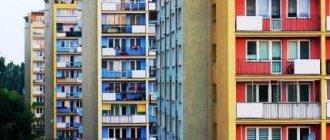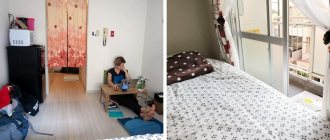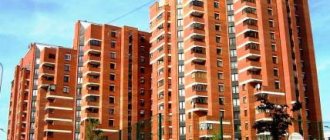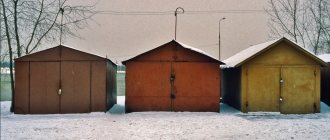Use of land near the house
There is a text of the Rules for the maintenance of property in houses with a large number of apartments; it talks in detail about what the local area of any property consists of:
- These are any objects without which normal operation of the house becomes impossible;
- Heating points;
- Transformer substations;
- Fire lanes;
- Collective parking lots and clothes dryers;
- Areas for children's recreation and sports;
- Elements involved in landscaping and landscaping;
- A plot of land with an erected building.
Owners do not have the right to restrict access to the land located around the house.
It is only possible to install paid parking, place advertising boards, and lease out part of the area.
Money from these activities can be used for general house needs.
Only at a general meeting can residents decide what exactly this or that object will be used for.
The main and most common purpose is the installation of fencing posts, arrangement of parking lots, planting trees, construction of entertainment areas.
received should also be distributed collectively .
Advantages and disadvantages of the local area in the property
Positive points may be as follows:
- Free implementation of privatization;
- Additional profit that can be spent on improving the territory and solving other issues;
- An excellent opportunity to protect your yard from construction that violates the law.
Allocating the local area as common property for residents means obtaining the right to dispose of this object at their own discretion.
But there are also some negative aspects of the process:
- Everything related to maintenance and repair falls on the shoulders of the home owners;
- It is only possible to place garages for participants and veterans of the Second World War, sports and children's playgrounds;
- You cannot do without paying taxes on land.
This is important to know: New landscaping rules 2021
Maintenance Responsibilities
The parameters of the adjacent land - area, limits - are displayed in the cadastral passport. This information is the basis for calculating the costs of management companies for cleaning this place. If the area of the local area is not properly designed, then responsibility for its maintenance rests with the municipal administration.
Correctly managing not only the object itself, but also the land adjacent to it, you can significantly reduce costs and increase the comfort of living. Each locality develops its own set of rules. However, they always contain universal components created on standard sanitary standards. The main work consists of:
- Cleaning the local area. Snow is unconditionally removed from access roads and sidewalks, entrances and address signs are cleaned.
- Work in the field of formation of areas where children rest.
- Fencing the area or its components. The basics are to take into account the range of interests of residents in nearby houses.
- The yard arrangement of parking for motorists is extremely important; many factors depend on where personal vehicles are located.
- Organize the operation of waste disposal sites.
- Planting and processing. It is necessary to form lawns, plant bushes and trees, and landscape the area.
- Erect the necessary buildings, install fences, carry out their scheduled repairs.
Almost everything depends on how the owners themselves relate to this, to what extent they proactively look after their own home and the surrounding area is always in a tidy condition. It is very important to fulfill the requirements for landscaping, at least to a small extent, and in most cases, developers are responsible for performing one-time work.
The process of registering land ownership
Before starting the procedure, it is recommended to study the existing regulations in detail.
A very important second stage is the gathering of residents at a general meeting. This is where voting is held on this issue.
Voting will take place if it is possible to get more than half of the positive votes, including managers. At this meeting, you need to choose the person in whose name the property is registered, and deal with all the nuances of paperwork;
Everyone turns to the land management organization as owners of apartment premises.
Each subject of the Russian Federation has a branch of this public service.
The application must indicate the request regarding the formation of the relevant site;
One of the most important issues related to registration is decision making. At the same time, each subject of our country has its own peculiarities of the procedure.
It is best to seek the help of professional lawyers.
Article 16 in the Federal Law of 2004, December 29, will become the main support;
Registration of property rights takes place in the manner strictly established by law.
Information about rights to real estate must be present in a unified register;
- The complete package of documents must be attached to the application.
Why hold an initiative group meeting?
But the idea must be supported by the owners of the premises at a general meeting. Therefore, before holding such a meeting, the initiative group, together with MA specialists, must work out their proposals and collect information. This is important for several reasons:
- At the same time, proactive residents of the house will confirm their desire to participate in the improvement of the yard and will be able to clearly define the request for changes: what, in their opinion, needs to be changed, what ideas they have, what to focus on.
- The issue of landscaping the yard should be brought up for discussion with a wide range of residents, including at a general meeting of owners, only after the initiators have specific proposals and clear questions. People don't like to be interrupted to discuss abstract ideas.
- It is necessary to determine in advance possible sources of financing the work: from funds for current or major repairs, from targeted contributions from residents of the house, through participation in municipal and federal target programs.
Representatives of the Management Organization must be present at meetings of the initiative group. They will help residents of the house understand the legislation that regulates the improvement of courtyards, prepare information and documents for the OSS.
Land plot as part of the common property of the MKD
1149742
A little about the consequences
The use of such territory is always subject to taxes . They are based on Article 388 of the Tax Code.
Self-payment of tax through a current account is provided for persons with the status of individual entrepreneurs and individuals. As for an individual, for him the moment of payment occurs at the same time when a notification is received from representatives of the tax service.
The surrounding area as a whole is transferred to shared ownership in no less than 4-7 months. With the help of specialists, you can always get oral and written advice on any issue.
What do you need to know before you start registering your local area as your property?
First, it’s worth understanding what the concept of a local area includes, and what role it plays for residents and the house. In order to carry out activities for landscaping, landscaping and construction of new buildings and objects on the land around a multi-apartment residential building, you need to know who owns this land. Any issues related to adjacent plots and the processes of their registration are regulated by the Housing Code of the Russian Federation. The boundaries of the local area are determined in accordance with the Land Code and the law on urban planning.
In Russia, each plot of land must be registered in the cadastral register, and before that it must be demarcated. This also applies to territories adjacent to the MKD.
When purchasing an apartment, a person receives only square meters in the house. The adjacent land is not automatically included in the right of ownership in this case. However, if desired, anyone has the right to register ownership of a plot by going through a legislative procedure, as a result of which the plot will receive its own number and be registered in the cadastre.
The adjacent territory of an apartment building, according to the Rules for the maintenance of property in apartment buildings, consists of:
What are the stages of registration of common land area?
All issues that concern the “life” of the apartment building are resolved at a general meeting of residents. If at such a meeting the owners decided to register the adjacent territory of the apartment building as their property, then an application is prepared for the local Department of Land Resources to transfer the site into common ownership.
It is also important at the general house meeting to select an authorized person who, independently or with the help of other residents, will take care of the registration procedure. It is this person who submits the application to local authorities.
This is important to know: How to register ownership of land if it has been used for more than 20 years
After this, they begin to determine the boundaries of the site. The local administration forms the site and carries out land surveying (if necessary). When the boundary design is ready, the local authorities approve a decision that the territory will be transferred to the common ownership of the apartment building.
This is followed by registration in the cadastre and obtaining the status of owners in Rosreestr. There are several ways to register property in Rosreestr: through a personal visit to the authority, through electronic services or by post. In this case, be sure to attach a receipt for payment of the state duty.
The following legal acts and laws will help you understand issues related to the registration of the local area as common property:
- Articles 33, 34, 36, 37, 44 LC;
- Federal Law requirements numbered 189 (dated 12/29/2004), 191 (dated 12/29/2004), 221 (07/24/2007);
- Government Decrees numbered 576 (08/07/2002) and 1223 (08/21/2000).
Parking questions
The procedure for organizing parking and parking zones in courtyards is always the main criterion for design. Already during the design period of the building, the order of location of the packing areas is envisaged, which is used when creating a parking lot in the yard and the surrounding area. Owners can use these principles at the stage when they are drawing up a plan for the local area of an apartment building (in accordance with SNiP) and create additional parking lots, arrangement of personal garages, but the following should be taken into account:
- the distance from a parking lot accommodating up to ten cars to the building of a residential building should be at least ten meters, but to garages it can be a quarter more distance;
- it is possible to install garages on local land only if the exits from these garages do not face the buildings;
- The presence of an open parking lot is permitted, which can accommodate up to fifty vehicles. When we talk about parking spaces or garages with continuous wall fencing, in this case their capacity can be increased up to one hundred cars. If there is still not enough space, then it is possible to rent an additional area.
Residents can file a complaint if the parking lot provokes various obstacles and limits the residents’ opportunities to the appropriate governing bodies, this is the municipal or district city. administration, fire supervision, sanitary control services. Whenever disputes arise about parking cars in yards, you first need to examine the district regulations.
Traffic rules
The adjacent territory, in addition to these laws, is also regulated by traffic regulations, which delineate zones where parking is generally not permitted:
- The rules strictly prohibit idle time in the courtyards of vehicles with the engine running for more than five minutes, unless the necessary loading and unloading operations are performed or passengers are not boarded and disembarked. The importance of this principle increases with the arrival of winter time, if the driver needs to warm up the car;
- the adjacent territory of an apartment building establishes standards for parking and leaving cars on sidewalks, lawns, walkways and where transport will impede the movement of pedestrians or other vehicles (bicycles, scooters, etc.);
- It is prohibited to erect barriers independently, without permission, and thus secure parking spaces;
- It is not allowed to interfere with the passage and passage into the yard, or park the car at a distance closer than five meters. from trash cans;
- further, the adjacent territory of the apartment building prohibits the parking of trucks (over three and a half tons) outside specially designated areas; such a zone may be the territory paid for by a shopping center and industrial buildings located near it;
The owner of the car who mistakenly delivered his own car will have to pay the penalty. If such a situation with a would-be driver is repeated more than once, traffic police officers will raise the issue of depriving the offender of his driver’s license.
How to register common ownership in an apartment building?
To register common ownership in an apartment building, you first need to understand what it includes. According to Article 36 of the Housing Code of the Russian Federation, owners of premises in apartment buildings have the right to the common property of the house on the right of common shared ownership. Common household property includes:
- Premises of a house that are not apartments and are intended to serve one or more rooms in this house: attics, basements, landings with stairs, elevators with elevator shafts, corridors, etc.
- Premises that do not belong to individual owners, whose purpose is to satisfy social and domestic needs, as well as premises in which residents can spend leisure time, engage in physical education and sports, as well as other activities.
- Roofs, mechanical equipment, and plumbing lines that are located inside the home.
- Land plot under the house.
Owners of premises in an apartment building receive ownership of common property from the moment their rights to these premises are registered in proportion to their share. There is no additional need to register rights to common household property.
The Housing Code and Civil Legislation establish standards for the use of common property by owners of apartment buildings.
Is a general meeting of residents necessary?
A general meeting of residents of the building, the territory of which is registered as common property, is necessary. This procedure is established by the Rules for the maintenance of common property (Government Decree No. 491 of August 13, 2006) and Art. 36 of the Housing Code.
The minutes drawn up as a result of such a meeting are submitted, along with the rest of the documentation, to municipal or government agencies to resolve the issue of privatization as common property of residents.
How much land does each house have?
There is no single standard. Most often, an apartment building has a local area, the dimensions of which are recorded in the cadastral passport (exact data can be obtained by making a request to Rosreestr). It is important to understand the terms: we are really talking not only about the land that the building occupies, but also about the surrounding area. However, this can be either a narrow front garden along the house or an area on which there is a playground and parking. In accordance with the current provisions of the Housing Code of the Russian Federation (more precisely, clause 4, part 1, article 36), this territory can be appropriated by residents on the basis of common shared ownership.
What part of the land plot is the property of the house owner
To clearly understand the boundaries of his property, the owner of a private house must learn how to define these zones. There is nothing difficult about this process.
Plan of the boundaries of the land plot of a private house
It is enough to simply study in detail the cadastral passport, which fully describes the limits of the land plot that are the property of the owner of the real estate.
On the territory of his plot, the owner can carry out any transformations, organize a personal plot, in the space of a house and land plot, the owner can implement any project that is convenient for a comfortable life for a private owner. The main thing is that all actions meet the prescribed standards and requirements of legislative projects.
I found out that the boundaries of the local area have not been formed - what should I do?
If the cadastral passport does not contain information about the formed plot, do not rush to despair. Any of the owners or a group elected at a general house meeting can apply to a state authority or local government with a request to allocate and fix the local area (in accordance with Parts 3, 4 of Article 16 of the Law of December 29, 2004 N 189-FZ and Letters of the Ministry of Economic Development of Russia dated 10/05/2017 N D23i-5777). For example, in Moscow, this issue is dealt with by the City Property Department - it enters data into the cadastral map if the site is demarcated.
If there was no land surveying, you should call a cadastral engineer. First, he develops a land surveying project, which should be agreed upon with the owners of neighboring plots. This plan is approved by the city and submitted to public hearings. After this, the engineer prepares the final boundary plan and submits it for registration himself or gives it to the owners of the apartment building so that they submit an application to Rosreestr.
We checked the cadastral passport and held a meeting, what next?
It is necessary to submit documents to Rosreestr for cadastral registration and registration of the plot as shared ownership. This can be done in person at Rosreestr or MFC, by mail or on the Rosreestr website. Before submitting documents, you need to pay a fee for the service (currently it is 200 rubles).
The list of documents is as follows:
- application for state registration and registration of the right of common shared ownership of common property in an apartment building;
- a document certifying the identity of the applicant or a person authorized by him, a document confirming the authority of the representative;
- cadastral plan or documents on the formation by a state authority or local government of the land plot on which the apartment building is located,
- decision of the general meeting of owners of premises in an apartment building on the formation of the land plot on which the apartment building is located;
- minutes of the general meeting of premises owners on determining shares in the right of common shared ownership of common property in an apartment building;
- title documents confirming the rights of the owners of premises in an apartment building that arose before January 31, 1998 (if there are no records in the Unified State Register of State Registration of the existence of the rights of these owners).
So, what does all this give us?
After registering ownership of the land, you and your neighbors will be able to:
- independently make decisions on the construction of children's playgrounds on the site, as well as improve it at their own discretion, organize parking, etc.;
- rent out part of the land (and make a profit);
- guarantee yourself protection from unexpected interference in the life of the house by local authorities: without the consent of the owners, the authorities will not be able to transfer the adjacent plot for construction, organize the laying of new roads or communications on it;
- regulate interference with the territory: without the consent of the owners, it will be impossible to organize commercial enterprises (for example, open a car wash, build garages, etc.).
The procedure for installing fences
To protect the local area from vandalism and to protect themselves, residents sometimes decide to block it completely or partially. This could be a symbolic fence to mark boundaries or a full-fledged fence with a barrier and security.
Rules and legality of construction
There are no prohibitions on fencing the local area. To do this, it is enough to collect more than 50% of the votes of residents. However, the design should not interfere with the passage of emergency services and limit their access to the territory. Otherwise, the project will not be approved by the locality administration.
If an illegal installation occurs
The erection of fences is considered illegal if the consent of at least 2/3 of the residents is not obtained. It does not matter who owns the initiative - the owners or third parties. The complaint is filed either with the housing inspectorate or with the prosecutor's office. There they will check the information and, if the fence was erected illegally, they will issue an order to demolish it. Unauthorized construction not approved by local authorities is also considered illegal.
There are no downsides, right?
Of course, this cannot be done without a drop of ointment. You will have to come to terms with the fact that:
- the cost of services for maintaining the land plot will increase (especially since after the boundaries are determined, its area may increase);
- owners of the local area are required to be responsible for the maintenance of their land, which means that removing snow and garbage, repairing roads, sidewalks and landscaping elements, maintaining green spaces and all that stuff is now your responsibility;
- after registration of ownership, tax payments may increase (as the cadastral value of an apartment or non-residential premises may increase).









